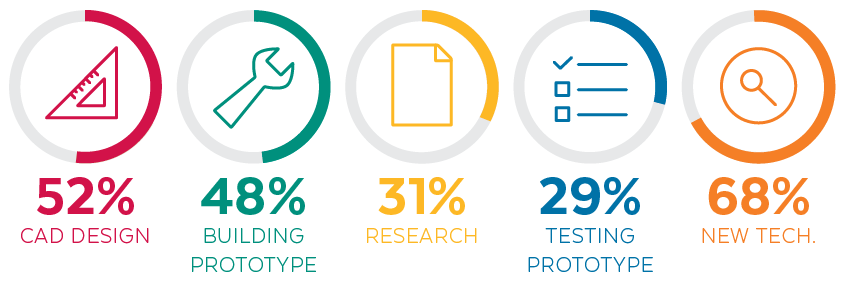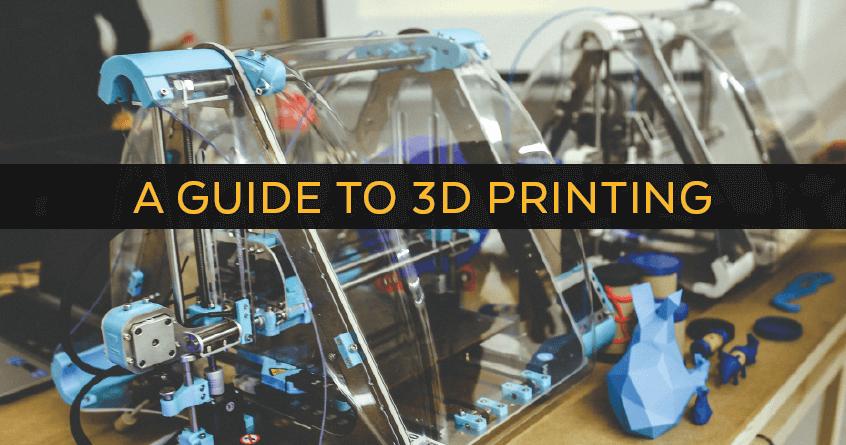There are many uses for 3D printing in a plethora of industries these days. Sculpteo, a France-based company specializing in 3D printing in the cloud, has undertaken an annual study1 for the past six years on the global state of 3D technology. The 2020 study involved 1600 respondents from various industries in 71 countries. This study produced some interesting statistics. The study found that the leading industrial uses in 2020 were CAD design (54 percent of the respondents), building prototypes (48 percent), research (31percent), and testing prototypes (29 percent). Also, 68 percent of the survey respondents expressed an eagerness to explore new 3D applications, technologies, and materials.

The purpose of this article is to present a basic overview of 3D printing. What is it? How does it work? What types of industries use it? What is the future of the industry?
What is 3D printing?
Three-dimensional printing, also called additive manufacturing (AM), entails assembling a real, physical object from a three-dimensional digital model. The 3D printing manufacturing technique is fundamentally distinct from any other form of manufacturing. The most fundamental and defining principle behind 3D printing is that it is an additive manufacturing process. More about that later.
A Brief History of 3D Printing
The first 3D process, called stereolithography (SLA), was invented in 1984 by Charles Hull. This new invention enabled the production of a 3D object from a digital design, thus giving birth to the concept of 3D printing. Shortly after, Hull’s company, South Carolina-based 3D systems, built the first 3D printing machines, called the Stereolithographic Apparatus—and then further developments were readily made from there.
In the middle to late 1990s, fully-functional body organs were produced and successfully transplanted into patients—the first of these being a synthetic scaffold coated with the patients’ body cells used in urinary bladder augmentation. This breakthrough showed that the raw materials for 3D printing could be anything from plastic to metal to human cells. The possibilities were endless.
In 2006, selective laser sintering (SLS) facilitated both mass and on-demand production of industrial parts. Further, the year 2008 saw the first printer capable of reproducing itself, as well as considerable breakthroughs in medical prosthetic fabrication. In early 2009, MakerBot Industries began selling DIY kits that allowed people to build their own desktop 3D computers. While in 2011, aerospace engineers from the University of Southampton designed, built, and flew the world’s first “printed” aircraft—the Southampton Laser Sintered Aircraft (SULSA).
In the years since, the 3D market continues to increase 3D applications. Industry leaders anticipate that the future will bring the integration of 3D printers with smart technologies like sensors and machine learning.
How does 3D printing work?
Traditional manufacturing processes use methods such as cutting and drilling to shape an object. On the contrary, 3D printers, under the control of a computer, take layer upon layer of powdered material and fuses them to produce an item.
Today’s 3D printers typically create objects using the SLS method as follows:
- First of all, the 3D printer has a vat that acts as a reservoir for the raw material. The raw materials used to form an object can include plastic, metals, resin, and polymers and are put into the vat.
- The 3D printer has a laser that is directed on the raw material to solidify and fuse each layer.
- The 3D printer has an elevator component that raises or lowers the object being manufactured. As the object is being made layer-by-layer, the elevator moves the object when needed to facilitate construction.
As stated above, the SLS process is typical for 3D printing; however, there are several different types.
What are the different types of 3D printing?
The ISO/ASTM 52900:20152 standard establishes and defines terms used in AM technology and has categorized 3D printing into these seven groups:
- Material Extrusion (FDM): Material is selectively dispensed through a nozzle or orifice
- Vat Polymerization (SLS & DLP): Liquid photopolymer in a vat is selectively cured by UV light.
- Powder Bed Fusion (SLS, DMLS, & SLM): a high-energy source selectively fuses powder particles
- Material Jetting (MJ): Droplets of material are selectively deposited and cured
- Binder Jetting (BJ): Liquid bonding agent selectively binds regions of a powder bed
- Direct Energy Deposition (LENS & LBMD): A high-energy source fuses material as it is deposited
- Sheet Lamination (LOM & UAM): sheets of material are bonded and formed layer-by-layer
What are some of the current applications for 3D printing?
The use of 3D printing is growing and improving at a fast pace, and many industries benefit from it. By looking at these industry applications, it is easy to see how and why 3D printers are changing manufacturing.
- Aerospace: Parts are complex, must be lightweight, and must adhere to the highest standards. Applications include creating castings for gear cases and covers, fuel tanks, transmission housings, components that require draft-free walls, lightweight engine parts, and structural hinges.
- Automotive: 3D printing technology is primarily used for the tooling and fixtures that assist in the manufacturing process—things like stiff, strong, and durable fixtures, cradles, and prototypes.
- Education: 3D printing is being offered at different levels to students of all ages. Students learn first to conceptualize and then complete their designs as they experience their project from the model stage to actual creation. At the college level, universities offer advanced courses on cutting-edge additive manufacturing materials and technology.
- Entertainment: 3D printing has taken these leisure industries by storm. They build prototypes for toys, dolls, action figures, musical equipment, games, etc. The film and TV industries use 3D printing for special effects, unique make-up (like monster masks), and movie props.
- Healthcare: Living human cells or tissue are being created by 3D bioprinting for use in the regenerative medicine and tissue engineering arena. Also, 3D printing is poised to offer new opportunities for the development of personalized medications. In July 2015, the FDA approved Aprecia Pharmaceuticals’ epilepsy drug called Spritam, which is currently the only approved 3D printed pharmaceutical on the market.
- Manufacturing: Both small and giant, global manufacturing companies use 3D printing to improve and expedite their processes. 3D printing technology enables these companies to create custom low-volume tooling and fixtures at a low cost.
What is the future of the industry?
Sculpteo states:
“With our annual study about the industry of additive manufacturing, The State of 3D Printing, we see the evolution of the uses of this technology. Businesses are confident in their use of technology. Businesses are investing more and more money each year to implement this additive technology at different levels of their company. From R&D to production and tooling, 3D printing now plays a significant role in a manufacturing and business context.”3
Industry experts make the following predictions 4 for the future of the industry:
- 3D printing will become a mainstream technology for serial production.
- Design software for additives will become more integrated and easier to use.
- Focusing on education will enable more 3D printing applications and adoption.
- Dental will adopt 3D printing as a dominant production technology.
- 3D printing will become smarter.
- The 3D printing service bureau market will continue to expand.
- Metal 3D printing will continue to mature.
- Composite 3D printing will offer a huge market opportunity.
- Automation will become a key focus for the industry.
- The additive manufacturing landscape will become more competitive.
- The predictions bulleted above truly portend a bright digital and smart future for this revolutionary industry.
Learn more about the IT networking equipment that helps support the development of technologies like 3D printing, at PLANET.
____________________________________
Further Reading:
1: Sculpteo: The State of 3D Printing-2020 Edition
2: 3D Hubs: The Complete Engineering Guide-3D Printing
3: Sculpteo: The Ultimate Guide: What is 3D Printing?
4: Autonomous Manufacturing (AMFG): 10 Predictions on the Future of 3D Printing (Expert Roundup)
